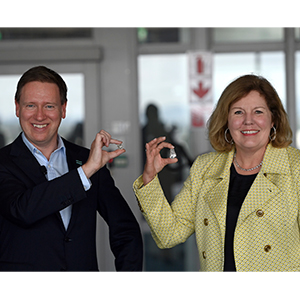
Gina Drosos has just finished her third trip to Botswana. Her first took place right after she was appointed Signet CEO, and she went to visit Signet’s cutting factory there. Prior to that, she’d traveled to Botswana as a tourist.
But her visit earlier this month was far more extensive, and included a get-together with De Beers CEO Al Cook as well as a visit to the Jwaneng mine. She also met with the U.S. ambassador to Botswana and the head of Okavango Diamond Company.
Drosos was accompanied on the trip by Jamie Singleton, Signet’s group president and chief customer officer; Joan Hilson, its chief financial, strategy, and services officer; and Colleen Rooney, chief communications and ESG officer. None of them had been to Botswana before—and it left a big impression. (Chief digital innovation officer Oded Edelman was also on the trip, but he’d already been to the country.)
“Botswana is just so impressive,” Drosos says. “This is a country that has a very precious natural resource—diamonds—and the government has worked with industry to leverage that natural resource to further the country and the people of that country.
“Botswana has gone from the lowest GDP country in Africa to one of the highest. The literacy rate went from among the lowest to among the highest. The education system is fantastic. Health care is excellent. It’s really such a smart way that the government has partnered with the industry to be able to advance the interest of the people.”
She adds that “even within Signet’s factory, we are now cutting and polishing more valuable diamonds in Botswana than ever. The skill sets of the 200 people who work there are wildly different and just better than we’ve had in the past. And as the workers gain more skill and experience, they can make more money, which then allows them to invest more in their communities.”
The Signet team left determined to better tell the “natural diamond story” to consumers, says Drosos.
“If you don’t know better, you might think, ‘Wow, digging a hole in the ground must be bad for the environment, and making lab-created must be good,’” she says. “But in fact in many ways the opposite can be true.
“Every time there’s a partnership between industry like De Beers and countries like Botswana to open a mine, there’s an endgame that’s decided from the very beginning. So. for example, with Jwaneng, when it’s depleted in however many decades, it will be filled back up and turned into a beautiful game preserve, which will then continue to contribute to the economy of Botswana in a very environmentally conscious way.
“[Consumers] could have the misconception that lab-created diamonds are good for the environment. However, we all know that the amount of energy that it takes to apply the heat and pressure to a piece of carbon and turn it into a diamond in three weeks in a lab— what would normally happen over hundreds of millions of years—that’s a lot of energy. We were all struck by wanting to tell those stories, and that is something the industry can do a better job with, and Signet can take a leadership role on.”
Drosos says Signet plans to “reintroduce” natural diamonds to consumers—who, for the past few years, have been hearing a lot about lab-grown.
“As the world’s largest retailer of diamond jewelry, what we try to do is offer across our different banners the perfect assortment and selection for customers at a fantastic value,” she says. “When customers are asking for lab-created, we carry it and we have competitive prices on it. So all of our decisions are made with the customer in mind.
“I do think that, over time, there is just such a specialness, especially in the engagement ring context, for people to get a natural diamond. It’s unique, it’s rare, it’s perfectly imperfect—just like people’s love for each other.
“Maybe for a fashion piece of jewelry, lab-created can offer a great value and make a lot of sense. But for my own engagement ring, I would only have a natural diamond because it is signifying something superspecial.”
She notes that Signet has always said that lab-created is a small part of its business—on her last earnings call, she said they accounted for just over 10% of diamond sales.
“We have always maintained a focus on natural diamonds, while offering customers choice,” she says. “I would expect us to continue to do that and maybe even to lean in a bit more to reintroduce customers to how wonderful natural diamonds are, especially since we feel so inspired coming back from this trip.”
Visiting a diamond-producing country inevitably raises the topic of planned G7 sanctions on Russian polished gems (which Signet stopped buying shortly after Russia invaded Ukraine). “What the G7 is talking about now is what Signet has already been doing,” Drosos says. “The role that we’re playing is to be collaborative, to share what we’re doing, to share some of the technology that we’ve been using in our responsible sourcing protocols.”
While Signet will likely have less trouble fulfilling the G7’s dictates than most companies, some in the industry worry the rules could be burdensome.
“We hope there will be more dialogue, so we can come to the best solution,” Drosos says.
Top: De Beers CEO Al Cook and Signet CEO Gina Drosos (photo courtesy of De Beers)
- Subscribe to the JCK News Daily
- Subscribe to the JCK Special Report
- Follow JCK on Instagram: @jckmagazine
- Follow JCK on X: @jckmagazine
- Follow JCK on Facebook: @jckmagazine






